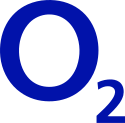Telefónica Germany
This article needs additional citations for verification. (May 2010) |
| File:Telefónica logo.png | |
| Company type | GmbH & Co. OHG |
|---|---|
| FWB: O2D | |
| Industry | Telecommunication |
| Predecessor | Viag Interkom (1995) |
| Founded | British Telecommunications (45%) VIAG (45%) Telenor (10%) |
| Headquarters | , |
Area served | Germany |
Key people | Thorsten Dirks (CEO) |
| Services | Telecommunications Internet Service Provider |
| Revenue | |
Number of employees | 5288 (2010) |
| Parent | Telefónica |
| Website | www www |
Telefónica Germany GmbH & Co. OHG (pronounced [teləˌfɔnɪkaː ˈdʒœːɐ̯məniː]; also called Telefónica Deutschland [-ˈdɔʏtʃlant]) is a provider of broadband, landline and mobile telecommunications in Germany. The company trades as O2 (typeset as O2) and O2 DSL (former Alice).
The company was renamed from Telefónica O2 Germany to Telefónica Germany on April 1, 2011 following the completion of a merger with HanseNet. Telefónica Germany purchased E-Plus on 1 October 2014, unifying the business under O2 brand on 3 February 2016.[1] Telefónica Germany's main competitors are Telekom Deutschland (Deutsche Telekom's German private customer unit) and Vodafone.
History

Originally launched in 1995 as Viag Interkom, it was a joint venture between British Telecommunications (45%), VIAG (45%) and Telenor (10%).
In 2001, BT acquired VIAGs remaining shares for €11.4 billion, and the company was renamed BT Germany, it became a part of BT Wireless, a group of subsidiary companies owned by BT. BT Wireless demerged from BT in 2001 to form mmO2 plc and Viag Interkom was relaunched as O2 Germany.
In 2005, mmO2 plc. of which O2 Germany is a part, was acquired by Spanish telecoms giant, Telefónica. O2 Germany rebranded as Telefónica O2 Germany GmbH.
In 2011, Telefónica O2 Germany merged with HanseNet and renamed the merged company to Telefónica Germany.
In September 2014, Telefónica Germany announced the sale of €3.62 billion in new stock to help finance the acquisition of its competitor E-Plus from KPN. As part of the purchase, Telefónica reduced its stake in its subsidiary to 62.1%.[2]
Products
Telefónica Germany operates second, third and fourth generation mobile networks, allowing customers to use GPRS, EDGE, UMTS up to HSPA+ and LTE for data connections. Most of O2 plans are available both in a pre- and post-paid version, including the all-in-one-flatrates called o2 o and o2 on for enterprise customers. Beside the core business, Telefónica Germany is one of the largest retailers for mobile phones and tablets without a SIM lock. It was the first operator offering both Apple's iPhone 4 and the iPad 2.[3] Also, Telefónica Germany offers hosting services for large and midsized companies, serving some well-known portals including Spiegel Online and Sevenload.[4] Together with Microsoft and Visionapp, Telefónica Germany provides a cloud service for Hosted Exchange.[5]
References
- ^ Telefónica Deutschland transfers BASE and E-Plus tariffs to the O2 brand world telefonica.de
- ^ Cornelius, Rahn; Rauwald, Christoph (September 9, 2014). "Telefonica Germany to Raise $4.7 Billion in Stock for E-Plus". Bloomberg Businessweek. Retrieved September 9, 2014.
- ^ O2 offering iPad 2 for Business Customers, Netzwelt, last access on October 22nd, 2011 (german)
- ^ Telefónica Germany founds Hosting Subsidiary (press release)
- ^ Review of o2 Hosted Exchange E-Mail Service (german)


